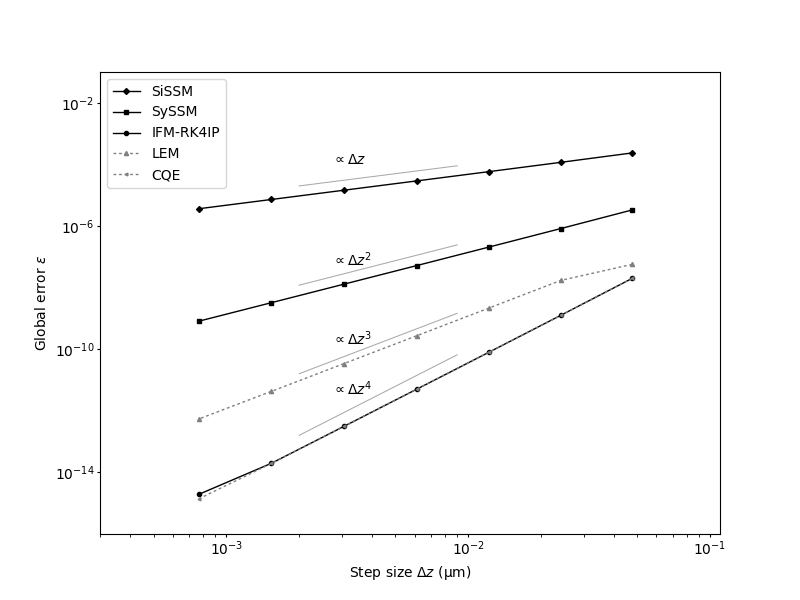Note
Click here to download the full example code
1.5.3. Scaling behavior of global errors¶
This example demonstrates the accuracy of the various \(z\)-propagation algorithms. As test case, the propagation dynamics of a fundamental soliton in terms of the standard nonlinear Schrödinger equation is considered. For this particular case, an exact solution is available to which a numerical approximation can be compared to.
We first import the functionality needed to perform the sequence of numerical experiments:
import sys
import numpy as np
import numpy.fft as nfft
from fmas.models import ModelBaseClass
from fmas.config import FTFREQ, FT, IFT, C0
from fmas.solver import SiSSM, SySSM, IFM_RK4IP, LEM_SySSM, CQE
from fmas.grid import Grid
Next, we implement a model for the nonlinear Schrödinger equation. In particular, we here consider the standard nonlinear Schrödinger equation, given by
wherein \(u = u(z, t)\) represents the slowly varying pulse envelope, \(\beta_2=-1\) is the second order dispersion parameter, and \(\gamma=1\) is the nonlinear parameter:
class NSE(ModelBaseClass):
def __init__(self, w, b2 = -1.0, gamma = 1.):
super().__init__(w, 0.5*b2*w*w)
self.gamma = gamma
@property
def Lw(self):
return 1j*self.beta_w
def Nw(self, uw):
ut = IFT(uw)
return 1j*self.gamma*FT(np.abs(ut)**2*ut)
Next, we implement a function that performs a single numerical experiment, in which a single fundamental soliton is propagated for a specified distance.
The exact single-soliton solution of the above nonlinar Schrödinger equation is given by
with \(P_0=|\beta_2|/(\gamma t_0^2)\). We here consider a fundamental soliton of duration \(t_0=1\) and use \(u_{\rm{exact}}(0,t)\) as initial condition. The propagation is performed up to \(z_{\rm{max}}=\pi/2\), i.e. for one soliton period.
The function below performs a parameter sweep over a range of step sizes \(\Delta z\), and compares the approximate solution \(u(z_{\rm{max}},t)\) at the final position, obtained for a specified \(z\)-propagation algorithm, to the exact solution \(u_{\rm{exact}}(z_{\rm{max}},t)\) at that point. This is done by computing the average relative intensity error, given by
This error measure was also used in [H2007] to compare the performance of different \(z\)-propagation algorithms. The function then returns the sequence of step sizes and the corresponding error values:
def determine_error(mode):
# -- SET AXES
grid = Grid( t_max = 50., t_num = 2**12)
t, w = grid.t, grid.w
# -- INITIALIZATION STAGE
# ... SET MODEL
b2 = -1.
gamma = 1.
model = NSE(w, b2, gamma)
# ... SET SOLVER TYPE
switcher = {
'SiSSM': SiSSM(model.Lw, model.Nw),
'SySSM': SySSM(model.Lw, model.Nw),
'IFM': IFM_RK4IP(model.Lw, model.Nw),
'LEM': LEM_SySSM(model.Lw, model.Nw),
'CQE': CQE(model.Lw, model.Nw, del_G=1e-6)
}
try:
my_solver = switcher[mode]
except KeyError:
print('NOTE: MODE MUST BE ONE OF', list(switcher.keys()))
raise
exit()
# -- AVERAGE RELATIVE INTENSITY ERROR
_RI_error = lambda x,y: np.sum(np.abs(np.abs(x)**2-np.abs(y)**2)/x.size/np.max(np.abs(y)**2))
# -- SET TEST PULSE PROPERTIES (FUNDAMENTAL SOLITON)
t0 = 1. # duration
P0 = np.abs(b2)/t0/t0/gamma # peak-intensity
LD = t0*t0/np.abs(b2) # dispersion length
# ... EXACT SOLUTION
u_exact = lambda z, t: np.sqrt(P0)*np.exp(0.5j*gamma*P0*z)/np.cosh(t/t0)
# ... INITIAL CONDITION FOR PROPAGATION
u0_t = u_exact(0.0, t)
res_dz = []
res_err = []
for z_num in [2**n for n in range(5,12)]:
# ... PROPAGATE INITIAL CONITION
my_solver.set_initial_condition(w, FT(u0_t))
my_solver.propagate(
z_range = 0.5*np.pi*LD,
n_steps = z_num,
n_skip = 8
)
# ... KEEP RESULTS
z_fin = my_solver.z[-1]
dz = z_fin/(z_num+1)
u_t_fin = my_solver.utz[-1]
u_t_fin_exact = u_exact(z_fin, t)
res_dz.append(dz)
res_err.append(_RI_error( u_t_fin, u_t_fin_exact))
# ... CLEAR DATA FIELDS
my_solver.clear()
return np.asarray(res_dz), np.asarray(res_err)
Finally, we prepare a figure that shows the scaling behavior of the resulting relative intensity error for the different propagation algorithms side-by-side:
import matplotlib as mpl
import matplotlib.pyplot as plt
import matplotlib.colors as col
f, ax = plt.subplots(1, 1, figsize=(8,6))
col1 = col12 = 'k'
dz, err = determine_error("SiSSM")
l1 = ax.plot(dz, err, color=col1, marker='D', markersize=3., markerfacecolor=col1, linewidth=1, label=r'SiSSM')
dz, err = determine_error("SySSM")
l2 = ax.plot(dz, err, color=col1, marker='s', markersize=3., markerfacecolor=col12, linewidth=1., label=r'SySSM')
dz, err = determine_error("IFM")
l3 = ax.plot(dz, err, color=col1, marker='o', markersize=3., markerfacecolor=col12, linewidth=1., label=r'IFM-RK4IP')
col1 = col12 = 'gray'
dz, err = determine_error("LEM")
l4 = ax.plot(dz, err, color=col1, marker='^', markersize=3., markerfacecolor=col12, linewidth=1., dashes=[2,2], mew = 1., label=r'LEM')
dz, err = determine_error("CQE")
l5 = ax.plot(dz, err, color=col1, marker='<', markersize=2., markerfacecolor=col12, linewidth=1., mew= 1., dashes=[2,2], label=r'CQE')
ax.legend()
line = lambda a, b, x: a*x**b
dz_ = np.linspace(2e-3,9e-3,5)
ax.plot(dz_, line(0.010, 1, dz_), linewidth=0.75, color='darkgray')
ax.plot(dz_, line(0.003, 2, dz_), linewidth=0.75, color='darkgray')
ax.plot(dz_, line(0.002, 3, dz_), linewidth=0.75, color='darkgray')
ax.plot(dz_, line(0.01, 4, dz_), linewidth=0.75, color='darkgray')
ax.text( 0.375, 0.80, r'$\propto \Delta z$', transform=ax.transAxes)
ax.text( 0.375, 0.58, r'$\propto \Delta z^2$', transform=ax.transAxes)
ax.text( 0.375, 0.41, r'$\propto \Delta z^3$', transform=ax.transAxes)
ax.text( 0.375, 0.30, r'$\propto \Delta z^4$', transform=ax.transAxes)
dz_lim = (3e-4,0.11)
dz_ticks = (1e-3, 1e-2, 1e-1)
ax.tick_params(axis='x', length=2., pad=2, top=False)
ax.set_xscale('log')
ax.set_xlim(dz_lim)
ax.set_xticks(dz_ticks)
ax.set_xlabel(r"Step size $\Delta z~\mathrm{(\mu m)}$")
err_lim = (0.1e-15,1e-1)
err_ticks = (1e-14,1e-10,1e-6,1e-2)
ax.tick_params(axis='y', length=2., pad=2, top=False)
ax.set_yscale('log')
ax.set_ylim(err_lim)
ax.set_yticks(err_ticks)
ax.set_ylabel(r"Global error $\epsilon$")
plt.show()

References:
- H2007
J. Hult, A Fourth-Order Runge–Kutta in the Inter- action Picture Method for Simulating Supercontin- uum Generation in Optical Fibers, IEEE J. Light- wave Tech. 25 (2007) 3770, https://doi.org/10.1109/JLT.2007.909373.
Total running time of the script: ( 0 minutes 30.750 seconds)